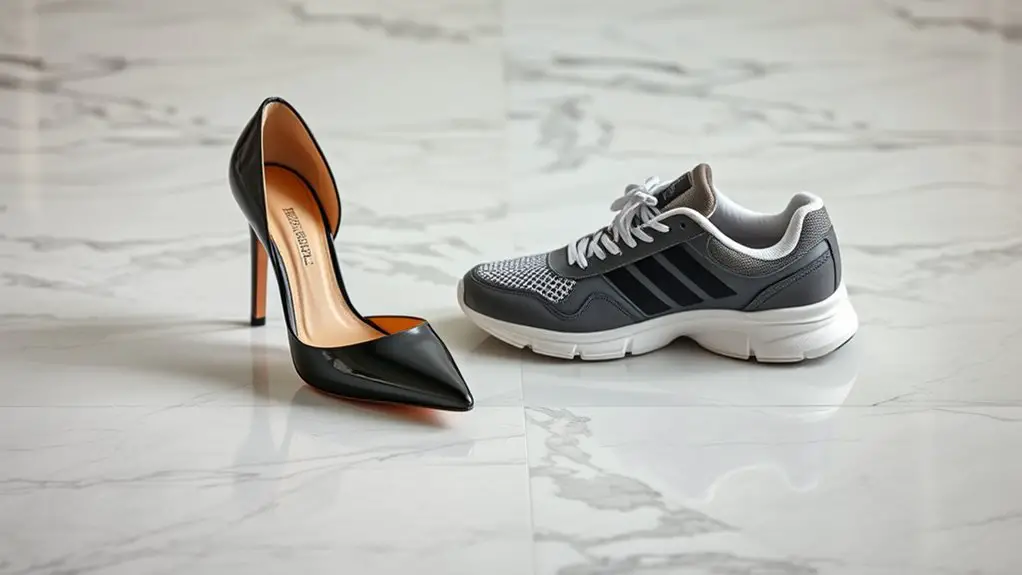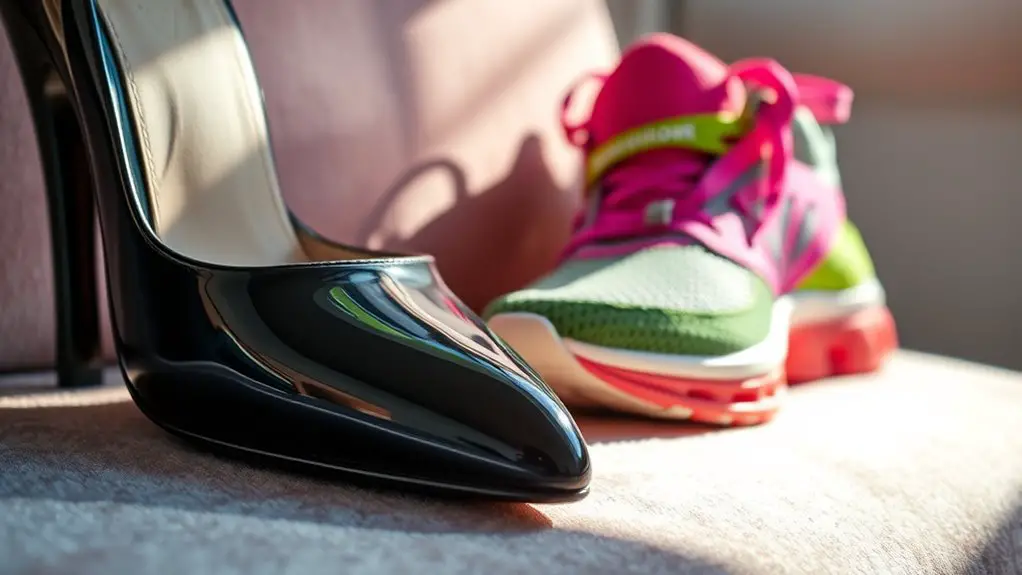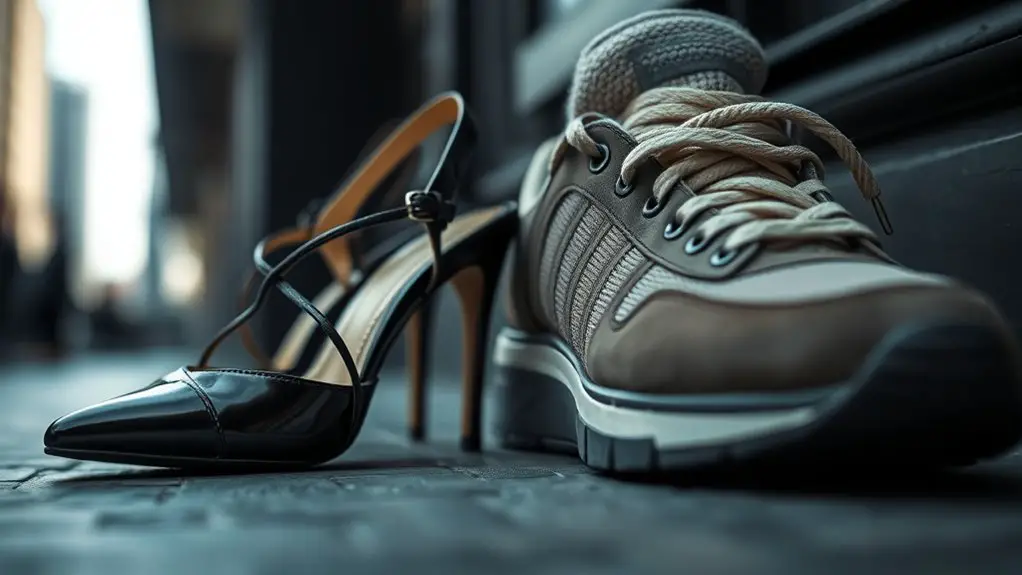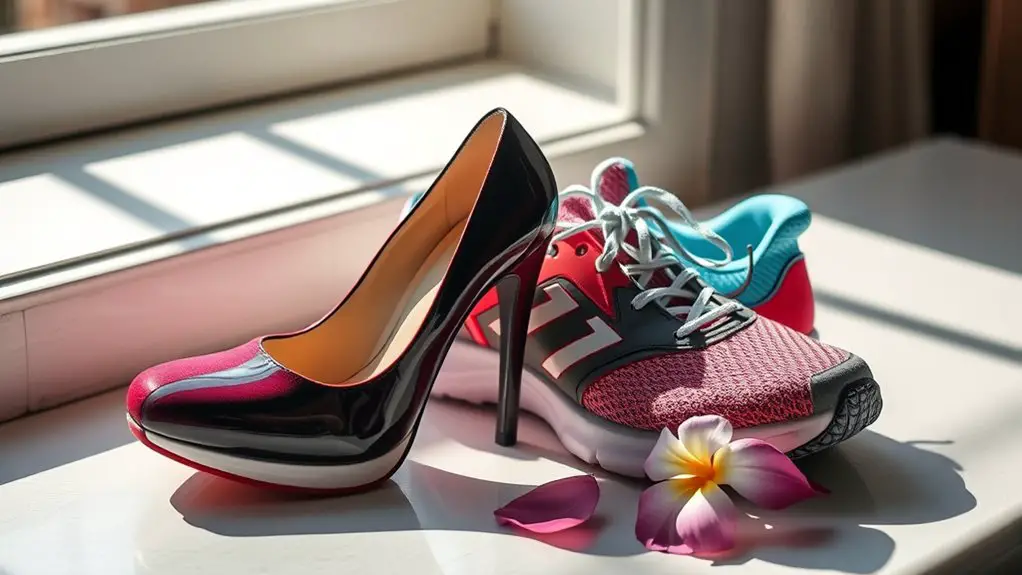High heels often can’t match the comfort of sneakers, particularly for long-term wear. Their design prioritizes style over support, creating challenges like foot pain and instability. Innovations in heel technology have improved cushioning and fit, but they still lag behind the breathable materials and flexible outsoles of sneakers. When considering fashion vs. comfort, it’s crucial to weigh your options carefully. Discover how you can choose high heels that elevate your style without sacrificing comfort.
The Anatomy of High Heels: Understanding Design Elements

High heels are more than just a fashion statement; they’re a complex blend of design elements that impact both aesthetics and comfort. To truly appreciate high heel anatomy, you need to reflect on several key components. The heel height, for instance, isn’t just a style choice; it alters your posture and weight distribution. A stiletto, with its slender design, creates an elongated silhouette but can strain your feet. Meanwhile, a block heel offers stability, distributing weight more evenly.
The toe box is another critical design element. A narrow toe box may enhance elegance but can sacrifice comfort, leading to pinched toes. Additionally, the arch support varies greatly across styles; some incorporate cushioning, while others focus solely on visual appeal. Understanding these elements helps you navigate the delicate balance between style and comfort when choosing high heels, ensuring you’re not just looking good but also being mindful of your feet’s well-being.
Comfort Innovations in High Heel Technology
When it comes to high heels, comfort innovations are transforming how you experience elegance. With advancements in cushioning and arch support, these heels are designed to keep your feet happy without sacrificing style. Plus, adjustable fit features guarantee a personalized touch, allowing you to strut confidently, no matter the occasion.
Cushioning and Arch Support
While many still associate high heels with discomfort, recent innovations in cushioning and arch support are transforming this perception. You’ll find that modern high heels now incorporate advanced cushioning technology, providing a plush feel that softens the impact on your feet. Brands are investing in materials that not only reduce pressure but also enhance overall comfort, making those long hours on your feet a little easier.
Additionally, arch support alternatives are becoming more prevalent, offering solutions that cater to different foot shapes and needs. With strategically placed support, these heels help maintain your foot’s natural position, reducing fatigue and discomfort. So, if you’ve shied away from heels in the past, it might be time to reconsider—style doesn’t have to mean sacrificing comfort anymore.
Adjustable Fit Features
The emergence of adjustable fit features in high heels is revolutionizing how we approach comfort in footwear. You’ll find that high heels equipped with adjustable straps allow for a personalized fit, accommodating various foot shapes and sizes. This innovative design not only enhances comfort but also provides essential support, reducing the risk of blisters and discomfort during long wear.
Additionally, custom inserts have become a game-changer, enabling you to tailor the cushioning and arch support to your unique needs. By incorporating these elements, high heels can now rival the comfort of sneakers, making it easier for you to strut in style without sacrificing your well-being. Embracing these advancements means you can enjoy elegance and ease all in one step.
Comparing Materials: Sneakers vs. High Heels

Choosing between high heels and sneakers often boils down to the materials that define these footwear options. Sneakers typically feature breathable mesh or soft leather, designed to enhance comfort and promote airflow, which helps in regulating temperature during wear. The material composition of sneakers often includes cushioned insoles and flexible outsoles, ensuring a supportive fit for all-day use.
In contrast, high heels often utilize materials like patent leather or suede, which can lack the same breathability factors. While these materials offer a sleek, stylish aesthetic, they can lead to discomfort due to limited ventilation and rigid structures. The elevated design of high heels also means that they may not incorporate the soft padding and arch support found in sneakers. Ultimately, understanding the differences in material composition can help you make an informed choice, balancing style with comfort according to your needs.
The Role of Footwear Fit in Comfort
Finding the right fit in footwear is just as important as the materials used. When it comes to comfort, understanding your foot shape and achieving ideal sizing can make all the difference. Ill-fitting shoes can lead to discomfort and even pain, whether you’re in high heels or sneakers.
Finding the right fit is essential for comfort, as ill-fitting shoes can lead to pain, regardless of style.
Consider these factors for a perfect fit:
- Arch support: Guarantees your foot’s natural curve is maintained.
- Toe box room: Allows your toes to move freely without cramping.
- Heel height: Affects balance and stability, especially in heels.
A shoe that conforms to your unique foot shape can reduce fatigue and enhance your overall experience. So, whether you’re strutting in stilettos or enjoying the ease of sneakers, remember that comfort starts with the right fit. Prioritizing these elements can help you stride confidently, no matter the occasion.
Tips for Choosing Comfortable High Heels

When you want to elevate your look with high heels, comfort shouldn’t take a backseat. Start by considering heel height; lower heels often provide better stability and comfort compared to sky-high options. If you’re new to high heels, opt for a heel that’s around two to three inches tall for a balance between style and ease.
Next, pay attention to your foot shape. If you have wider feet, look for brands that cater to your needs, as a snug fit can lead to discomfort. Choose shoes with cushioned insoles or arch support to enhance comfort. Additionally, materials matter—leather tends to mold better to your foot’s shape than synthetic options, providing a more personalized fit. Finally, try your heels on later in the day when your feet are slightly swollen to guarantee they’re comfortable during extended wear.
The Impact of Heel Height on Comfort Levels
When it comes to heel height, the balance between style and comfort is essential. A higher heel may enhance your silhouette but can compromise stability and arch support, leading to discomfort over time. Understanding how different heights affect your feet can help you make more informed choices for your wardrobe.
Heel Height and Stability
Heel height plays an essential role in determining the overall comfort and stability of footwear. The height impact can markedly influence how you feel throughout the day, especially when it comes to heel stability.
Consider these factors:
- Height: Lower heels generally provide better stability, reducing strain on your feet and legs.
- Platform Design: A thicker platform can counterbalance heel height, offering a more stable base.
- Foot Shape: Your unique foot structure can affect how different heel heights feel, so finding the right fit is vital.
When you choose a heel height that aligns with your lifestyle, you can enjoy a blend of fashion and function without sacrificing comfort. Remember, the right balance is key to maintaining stability while looking chic.
Arch Support Necessities
Finding the right heel height isn’t just about aesthetics; it directly influences the level of arch support your feet receive. When you choose heels with inadequate arch support types, like flat soles or excessively high heels, you may experience discomfort and fatigue. Ideally, heels between 1 to 2 inches often provide the best balance, allowing your arches to maintain some natural alignment while still offering style.
The benefits of proper arch support are significant—reducing fatigue, improving posture, and enhancing overall comfort. Incorporating cushioned insoles or selecting styles with built-in arch support can elevate your experience. Ultimately, prioritizing arch support in heel selection can help you strut your stuff without sacrificing comfort, making high heels more enjoyable to wear.
Styling High Heels for Function and Fashion
How can you elevate your outfits while ensuring comfort? Styling high heels for function and fashion is all about choosing the right pairs and pairing them with trendy outfits. Consider heel alternatives that offer stability without sacrificing style. Here are some tips to help you master this balance:
Elevate your style with high heels that prioritize comfort and stability while enhancing your fashionable outfits.
- Opt for Block Heels: They provide more surface area and support than stilettos, making them a comfortable choice.
- Pair with Tailored Pieces: High heels look chic with well-fitted trousers or a structured dress, enhancing your silhouette.
- Choose Neutral Colors: Versatile shades can complement various outfits, making mixing and matching effortless.
The Psychology of Wearing High Heels
Confidence often takes on a new height when you slip into a pair of high heels. This phenomenon isn’t just about the added inches; it taps into deeper psychological aspects of self-perception and social expectations. When you wear heels, you often feel empowered, embodying a confident persona that can command attention. This boost in self-confidence is linked to how society perceives femininity and professionalism. High heels can transform your posture, making you appear taller and more assertive, which can influence how others respond to you.
However, this psychological uplift comes with pressure. The expectation to wear heels can create a conflict between comfort and societal norms. You might find yourself caught between wanting to express your unique style and adhering to unwritten rules. Ultimately, understanding this psychology can help you navigate your choices, balancing comfort with the confidence that comes from meeting social expectations.
Real-Life Experiences: Comfort in High Heels vs. Sneakers
The choice between high heels and sneakers often reflects a personal negotiation between style and comfort. You might have your own personal anecdotes about occasions where you opted for one over the other. For many, sneakers deliver unmatched comfort, especially during long hours on the move. However, high heels can elevate an outfit, adding a flair that sneakers simply can’t match.
Consider these comfort preferences:
- Occasional Glamour: High heels can boost confidence for special events.
- Everyday Ease: Sneakers are often the go-to for running errands or casual outings.
- Long-Term Wear: You may find that after several hours, heels can become unbearable, while sneakers feel like a second skin.
Ultimately, it boils down to your lifestyle and what you prioritize on any given day. Whether you choose to strut or stroll, understanding your comfort preferences will guide your decision.
Frequently Asked Questions
Can High Heels Cause Long-Term Foot Problems?
High heels, like a tempting mirage, can lead to long-term foot problems. They alter your foot structure, creating discomfort and pain. Managing this pain requires awareness of your choices and prioritizing foot health over fleeting fashion.
Are There Specific Brands Known for Comfortable High Heels?
When searching for comfortable brands, consider those utilizing advanced heel technology. Brands like Clarks, Naturalizer, and Cole Haan design stylish options that prioritize comfort, making high heels more bearable for daily wear without sacrificing elegance.
How Do High Heels Affect Posture Over Time?
High heels, with their heel elevation, can markedly alter your spinal alignment over time. You might find your posture shifts, leading to discomfort or strain, especially if you wear them regularly without proper support.
Do Orthotics Work in High Heels as They Do in Sneakers?
Just as a rose blooms amidst thorns, orthotic inserts can enhance comfort in high heels, though heel height can complicate matters. They work differently compared to sneakers, offering support but not always the same level of relief.
Can Wearing High Heels Impact Overall Health?
Wearing high heels can substantially impact your overall health. The altered foot mechanics due to heel height may lead to pain and long-term issues, as they place undue stress on joints and muscles. Prioritize comfort and alignment.



